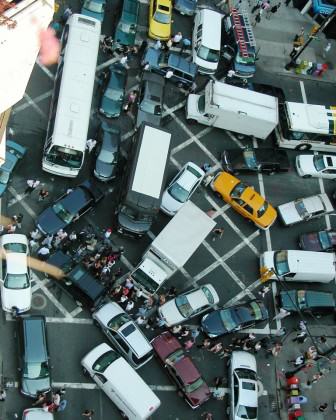Saturday, December 27, 2014
Forget the Motor Car
Forget the damned motor car and build cities for lovers and friends.
—Lewis Mumford, My Works and Days (1979)
When you think about it for a minute, you realize just how wasteful and unjust cars are of space. Though celebrated for their ability to abridge distance, cars are about the least effective way to use space that can be imagined. As a result, the nature of cities is diminished.
So, as a result of car dependence, most cities blithely commit 30% percent or more of their valuable urban space not to people or nature, but to cars, counted in millions of square feet (or meters) of streets, parking spaces, garages, and parking lots.
Think how absurd it is that skyscrapers, a thousand feet high, can be found going toe-to-toe with parking lots covered in a single layer of cars, yet downtown parking persists in the midst of the most valuable real estate in the world.
Why do we put up with that?
There are three reasons. One, once upon a time, we thought it was good idea to rip out public transportation and replace it with private ways of getting around. In the United States that time was the early twentieth century, when gas was remarkably cheap (on the order of 5 cents per gallon, cheaper than water in some places, cheaper even than oil is today with the fracking revolution) and streetcars were failing because of bad deals struck by government and industry, setting in motion patterns of disinvestment and disrepair. What America discovered with the car was a new way to make a buck, by paving over farmland near town for suburban development, a process now being replicated globally.
Reason two we suffer the car is millions of people depend on their own vehicles to get into town from their houses in the suburbs. These folks value the livability of their homes more than the livability of other peoples’ homes, so demand, through their dollars and their voting patterns and their incessant traffic, that society provide conduits and parking places for their steel boxes. Other people make money off of those people by selling us motor insurance, car loans, gasoline, tires, mechanical services, road paving services, ticket-writing services, and the wheeled boxes themselves. Governments recoup costs through registration and excise taxes. One would be enraged at such uncivil behavior, except “those people” and “those other people” are the same: us! We are all caught in the same self-perpetuating economic loop-de-loop of oil, cars, and suburbs.
Reason three we don’t change is that we have already invested so much into the roadways and the regulations and industries to support this car-mad way of life that change feels, smells, and sounds unthinkable, even if for the millions of people stuck in traffic, consciously or unconsciously, they can think of nothing else. In America, inertia reigns over the Republic. What galls, of course, is that so many other cities, in other countries around the world, are making exactly the same mistake America did and giving over lovely towns and cities and countrysides to automobiles…and their attendant problems.
Forget the Damned Motor Car (Sustainable Cities Collective)
Saturday, December 13, 2014
Can Urban Foraging Make City Dwellers Healthier?
Foraging for wild edibles has grown increasingly popular over the past few years. Educational tours are widespread. The menu at Copenhagen’s Noma, considered one of the world’s best restaurants, features almost exclusively foraged foods. Two and a half miles from downtown Seattle, urban farmers and foragers are in the process of developing a seven-acre food forest meant in part to encourage foraging. However, foraging is still associated more with parks and open land, than with bustling cities. Carlson and Stark are not aware of any other systematic studies of the availability of wild foods in urban areas.
The two scientists have begun taking inventory of wild foods growing in parts of Berkeley, Oakland, and Richmond where fresh food is scarce. So far, they’ve been surprised at the abundance of what they’ve found.
Nearing the end of summer and in a record drought, the team found ample plantago, mallow, dandelion, fennel, and dock. “I knew that even in the driest part of the year, there would still be some edibles available, but I was surprised by how much,” says Carlson. “We’re worried about where water is going to come from, and these plants are still plentiful.”
In addition to mapping the species occupancy of each neighborhood themselves, Carlson and Stark are encouraging their students to use the mobile app iNaturalist to crowd-source the data collection over the course of the next year. A record of what and how much they’ve found thus far can be found at forage.berkeley.edu. Samples of the plants will also be dried and deposited into the university’s herbarium collection.
Carlson and Stark have also begun testing soil samples for contaminants. So far, none of the toxins they’ve tested for have come close to surpassing acceptable threshold levels, with the exception of lead. But Stark says, “We think that the plants growing in even the worst soil we have found are in fact safe — but we’re going to check.”
Herbicides aren’t much of an issue either. As Stark put it: “Have you ever tried to eradicate dandelion from your yard? Good luck, unless you plan on using chemical weapons.” In other words, if herbicides were present, the wild edibles they’re finding probably wouldn’t be there. On the other hand, pesticides may prove to be a concern: On a recent mapping foray into West Oakland, they observed someone spraying for ants nearby.
Although both researchers are familiar with anecdotal evidence claiming wild edibles are more nutrient rich, they’re not yet willing to make that claim themselves. They won’t begin testing samples for their nutrient value until next spring, when the plants are more abundant.
Foragers’ Delight: Can Wild Foods Make City Dwellers Healthier? (Civil Eats) H/T laureth
Subscribe to:
Posts (Atom)

